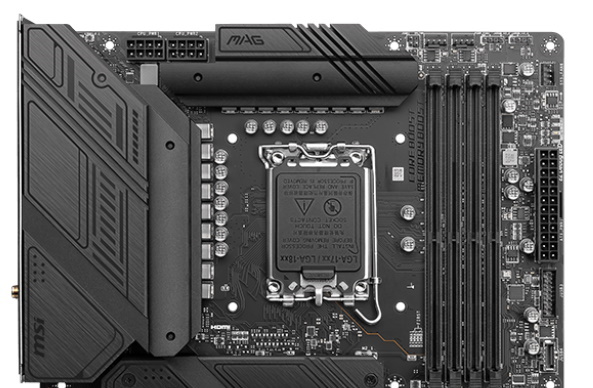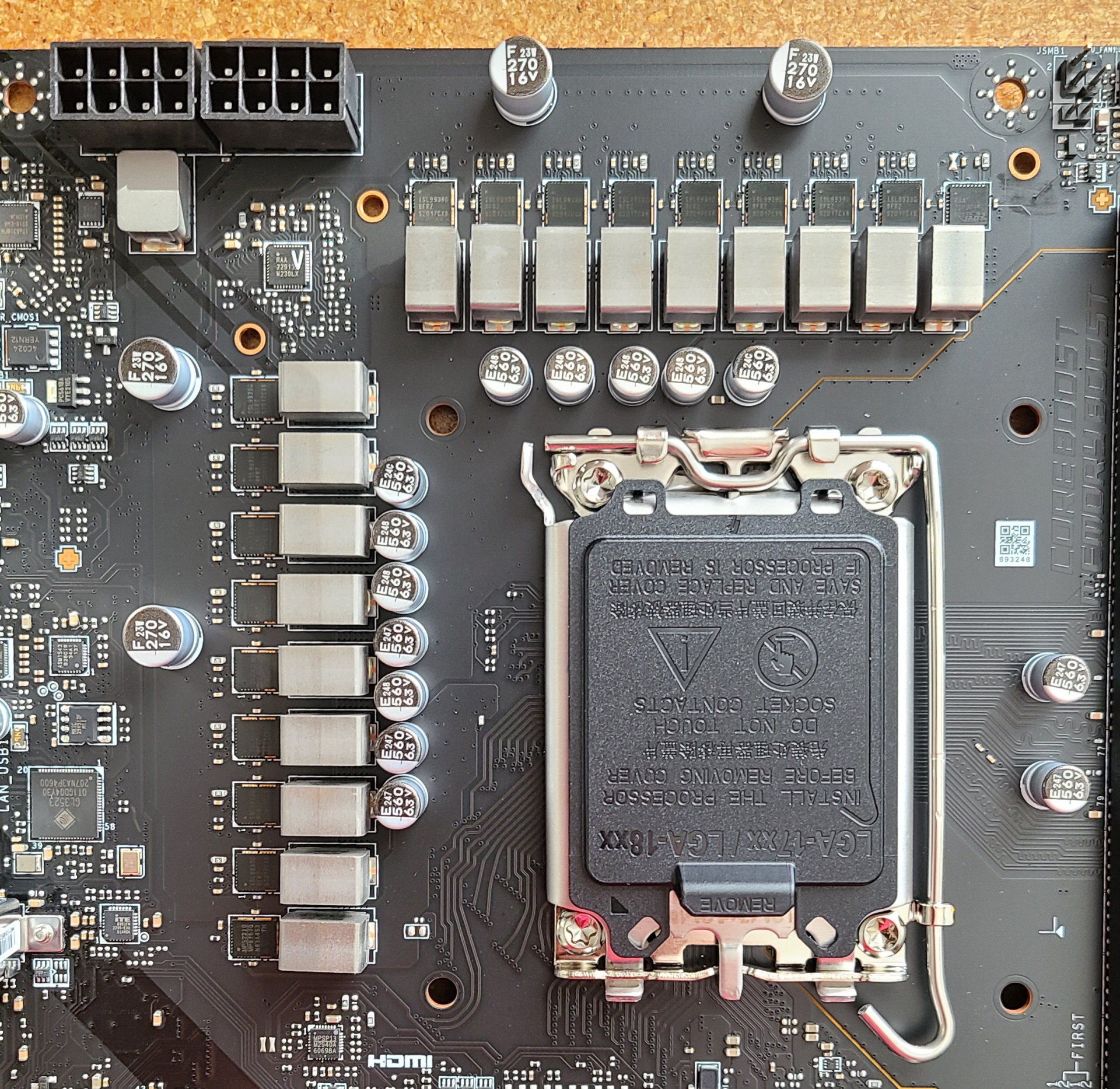Tom's Hardware Verdict
Priced around $300, the Z790 Tomahawk WIFI DDR4 is a solid board to build your Raptor Lake-based system on. It compares well hardware/specs-wise to the other boards and its all-black appearance blends in with most build themes. However, it’s priced high compared to its direct competition.
Pros
- +
Premium audio codec
- +
Integrated Wi-Fi 6E
- +
Capable power delivery
- +
EZ M.2 clips
Cons
- -
Lacks PCIe 5.0 M.2 socket
- -
Priced high among DDR4-based competition
Why you can trust Tom's Hardware
MSI’s MAG Z790 Tomahawk WIFI DDR4, our first MSI Z790 board, hails from the budget side of the product stack. Using DDR4 instead of DDR5 saves around $10-$20 on the motherboard cost and potentially a hundred dollars or more on the RAM itself. Going this route could save a lot of money (especially if you already have DDR4 RAM) that you can put into other parts, such as a video card.
At just over $300, the Tomahawk WIFI DDR4 is a full-featured option that gives you four M.2 sockets, a premium current-gen audio codec, capable power delivery, and the signature all-black appearance. Overall, it’s an attractive option in the budget Z790 space, although there are similarly equipped boards that currently cost less.
MSI’s Z790 product stack (at the time of this writing) consists of 14 motherboards in all shapes, sizes, and price points. At the top of the food chain are the MEG boards (Godlike, MEG Ace), followed by the MPG-class (Carbon WIFI, Edge WIFI, Edge WIFI DDr4, and Edge WIFI ITX). The less expensive MAG series has the Tomahawk WIFI in DDR4 and DDR5 flavors. Additionally, six “Pro” boards fill out the budget end of the company’s Z790 offerings.
Performance with our DDR4-based motherboard was solid nearly across the board. Where it lacked was mainly in the AIDA bandwidth tests, 7Zip compression, and Procyon Video editing – all were notably slower than our DDR5 systems. It did well in the Procyon Office tests and kept up with our other DDR5 offerings in the remainder of tests, including gaming. DDR4-based motherboards are just about as fast as DDR5 in utmost common tasks.
Below, we’ll dig into the details of the board and see whether it deserves a spot on our Best Motherboards list. Before we get into the nitty gritty, we’ll start by listing the specifications from the MSI website.
Specifications: MSI MAG Z790 Tomahawk WIFI DDR4
| Socket | LGA1700 |
| Chipset | Z790 |
| Form Factor | E-ATX |
| Voltage Regulator | 18 Phase (16x 90A SPS MOSFETs for Vcore) |
| Video Ports | (1) HDMI (v2.1) |
| Row 5 - Cell 0 | (1) DisplayPort (v1.4) |
| USB Ports | (1) USB 3.2 Gen 2x2 (20 Gbps) Type-C |
| Row 7 - Cell 0 | (1) USB 3.2 Gen 2 (10 Gbps) Type-C |
| Row 8 - Cell 0 | (4) USB 3.2 Gen 2 (10 Gbps) |
| Row 9 - Cell 0 | (4) USB 3.2 Gen 1 (5 Gbps) |
| Network Jacks | (1) 2.5 GbE |
| Audio Jacks | (5) Analog + SPDIF |
| Legacy Ports/Jacks | ✗ |
| Other Ports/Jack | ✗ |
| PCIe x16 | (1) v5.0 (x16) |
| Row 15 - Cell 0 | (1) v4.0 (x4) |
| PCIe x8 | ✗ |
| PCIe x4 | ✗ |
| PCIe x1 | (1) v.3.0 (x4) |
| CrossFire/SLI | AMD CrossFire |
| DIMM Slots | (4) DDR4 5333+(OC)*, 128GB Capacity |
| Row 21 - Cell 0 | 1DPC 1R Max speed up to 5333+ MHz |
| Row 22 - Cell 0 | 1DPC 2R Max speed up to 4800+ MHz |
| Row 23 - Cell 0 | 2DPC 1R Max speed up to 4400+ MHz |
| Row 24 - Cell 0 | 2DPC 2R Max speed up to 4000+ MHz |
| M.2 Sockets | (1) PCIe 5.0 x4 (128 Gbps) / PCIe (up to 80mm) |
| Row 26 - Cell 0 | (4) PCIe 4.0 x4 (64 Gbps) / PCIe (up to 80mm) |
| Row 27 - Cell 0 | Supports RAID 0/1/5 |
| U.2 Ports | ✗ |
| SATA Ports | (7) SATA3 6 Gbps (Supports RAID 0/1/5/10) |
| USB Headers | (1) USB v3.2 Gen 2, Type-C (10 Gbps) |
| Row 31 - Cell 0 | (2) USB v3.2 Gen 1 (5 Gbps) |
| Fan/Pump Headers | (8) 4-Pin (CPU, Pump, System Fan) |
| RGB Headers | (3) aRGB (3-pin) |
| Row 34 - Cell 0 | (1) RGB (4-pin) |
| Diagnostics Panel | (1) Dr. Debug |
| Row 36 - Cell 0 | (1) EZ Debug LEDs |
| Internal Button/Switch | ✗ |
| SATA Controllers | ASMedia ASM1061 |
| Ethernet Controller(s) | (1) Intel I-225V (2.5 GbE) |
| Wi-Fi / Bluetooth | Intel Wi-Fi 6E (2x2 ax, MU-MIMO, 2.4/5/6 GHz, 160 MHz, BT 5.3) |
| USB Controllers | ✗ |
| HD Audio Codec | Realtek ALC4080 |
| DDL/DTS | ✗ / ✗ |
| Warranty | 3 Years |
Inside the Box of the MSI MAG Z790 Tomahawk WIFI DDR4
MSI includes a couple of basic accessories along with the motherboard. This certainly isn’t a comprehensive accessory stack, but includes some of what you need to get started. Below is a complete list of the included accessories.
- Quick Install guide
- (2) SATA Data Cables
- EZ M.2 clips
- Wi-Fi antenna
- USB driver stick
- Cable stickers
Design of the MSI Z790 Tomahawk WIFI
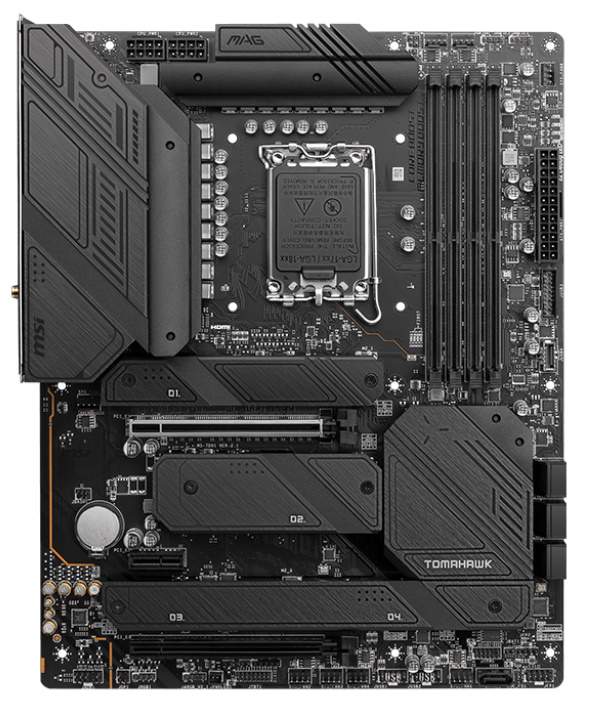
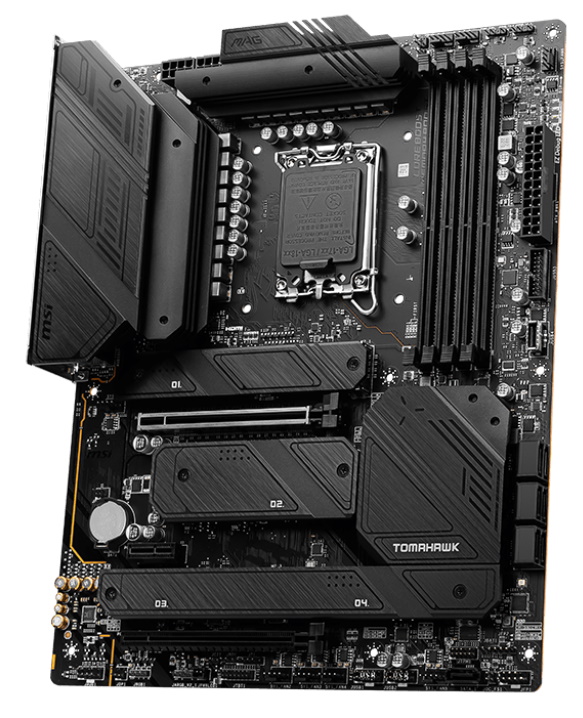
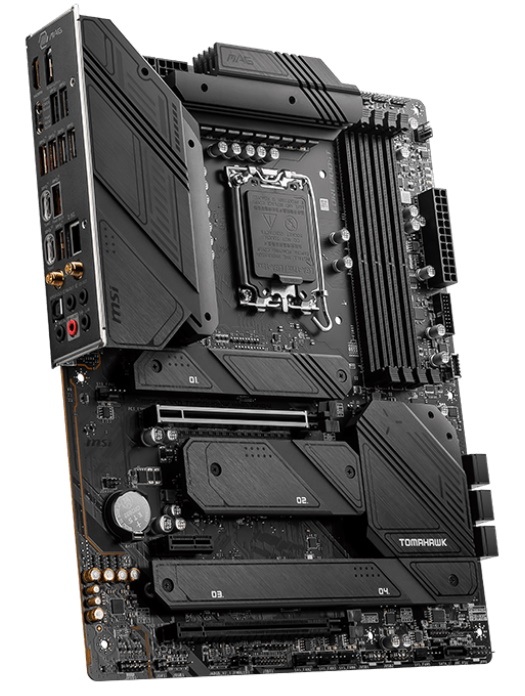
MSI’s Tomahawk boards use a military-style theme, with an all-black appearance including the 6-layer PCB. In fact, the only contrast on the board is the reinforced PCIe slot and some numbering for the M.2 sockets. The board uses large, heavy heatsinks around the VRMs, sporting a brushed aluminum finish and other aesthetic cutouts. If you’re looking for onboard RGB lighting, the Tomahawk doesn’t have any, but there are headers to add your own. Overall, the board fits in well with most build themes, and you can add your own RGB glow if needed.
Get Tom's Hardware's best news and in-depth reviews, straight to your inbox.
Starting with the top half of the board, we get a better look at the VRM heatsinks and their design elements. There isn’t a heatpipe shared between them, but the parts under the hood are good enough not to need a larger (and more costly) design. Sticking up between the two VRM heatsinks are two 8-pin EPS power connectors to feed the CPU (one required).
To the right of the socket, we run into four unreinforced DRAM slots with locking mechanisms on both sides. MSI lists support for up to DDR4 5333 and a capacity of 128GB. As expected, we had no issues with our DDR4 3600 or DDR4 4000 sticks. If I were to nit-pick about the RAM slots, I’d love to see single-side locking on the slots to make them easier to remove, but few will find this to be a concern.
Located above the DRAM slots, we spy our first two (of eight) fan headers and two (of four) RGB headers. Starting with the 4-pin fan headers, they all auto-detect if the attached device is PWM or DC-controlled. All of the System fan headers support 1A/12W, the CPU_Fan outputs up to 2A/24W, while the pump fan has the most at 3A/36W. Control over the attached 4-pin devices comes from the BIOS or the MSI Center software.
Along the right edge is another fan header, the EZ Debug LEDs, and the 24-pin ATX power connector supplying the board. Just below that is the front panel USB 3.2 Gen 1 (5 Gbps) header and a USB 3.2 Gen 2 (10 Gbps) header.
Moving on to the VRMs, power flows from the 8-pin EPS connector(s) onto a Renesas RAA229132 PWM controller. For Vcore, power then heads on to 16 90A Intersil ISL99390 SPS MOSFETs. The 1,440 Amps available can handle the flagship Intel Core i9-13900K at stock and overclocked. We have no concerns whatsoever about the Tomahawk’s power delivery.
On the bottom half of the board, we see a lot more of the PCB in this class than we do on the more expensive offerings. To that end, the audio section is fully exposed on the left, showing off the Realtek ALC 4080 codec and several dedicated gold audio capacitors. It may not have the fancy DAC some high-end boards come with, but it does have a latest-generation codec. Most users will be satisfied with this audio implementation.
In the middle of the board are a couple of PCIe slots, and all of the M.2 sockets. Starting with the slots, There are two full-length PCIe slots and one x1-size slot. The top full-length slot (primary graphics slot) is reinforced to prevent shearing from heavy video cards potentially help with EMI. This slot connects through the CPU and is the only one that is PCIe 5.0-capable. The bottom full-length slot connects through the chipset and runs up to PCIe 4.0 x4, while the x1 slot is PCIe 3.0 x1 and also sources its bandwidth from the chipset. Neither the specs nor the manual mention Crossfire support, even though it is capable bandwidth-wise.
For M.2 storage, there are four sockets mixed in among the PCIe slots. Starting from the top, M.2_1 sources its lanes from the CPU and supports up to PCIe 4.0 x4 (64 Gbps) modules up to 110mm. The next three sockets get their bandwidth from the chipset and run at PCIe 4.0 x4 (64Gbps) and up to 80mm modules. M.2_3 supports SATA-based storage devices as well as PCIe.
Across the bottom of the board are several exposed headers. You’ll find the usual, including additional USB ports, RGB headers, and power/reset buttons. Below is a complete list from left to right.
- Front panel audio
- 4-pin ARGB header
- 3-pin RGB header
- Thunderbolt header
- (3) System Fan headers
- (2) USB 2.0 headers
- (1) System Fan header
- SATA port
- System panel header
Out back on the preinstalled rear IO, the Z790 Tomahawk sports a black background with light grey labels on all of the ports. There are 10 USB ports: Six 10 Gbps ports (red, plus two Type-C), and four 5 Gbps ports (blue). The DisplayPort and HDMI ports sit on the far left, next to tiny clear CMOS and BIOS Flashback buttons. The Intel 2.5 GbE port is above one of the Type-C ports, with the Wi-Fi 6E antenna connections to the right, next to the 5-plug analog plus SPDIF audio stack.
MORE: Best Motherboards
MORE: How To Choose A Motherboard
MORE: All Motherboard Content

Joe Shields is a staff writer at Tom’s Hardware. He reviews motherboards and PC components.
-
AnotherNobody ReplyAdmin said:The MSI MAG Z790 Tomahawk WIFI DDR4 is a quality budget-oriented board that comes with premium audio codec, four M.2 sockets, capable power delivery, and more. Priced around $300, it’s a viable option but costs more than other similarly equipped DDR4 boards.
MSI MAG Z790 Tomahawk WIFI DDR4 Review: Stealthy and Solid : Read more
Form factor in specifications shows E-ATX. According to MSI (https://www.msi.com/Motherboard/MAG-Z790-TOMAHAWK-WIFI-DDR4/Specification) motherboard is in fact ATX, 243.84mmx304.8mm -
TheWhiteSnowman Please confirm test configuration you state DDR5 in this DDR4 motherboard review?Reply
